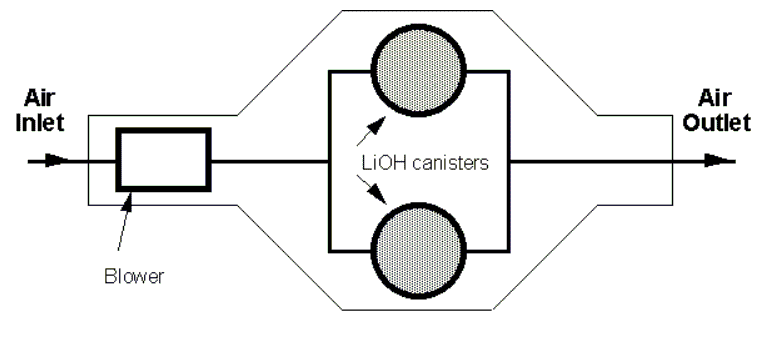 |
 |
 |
 |
Manned Operations |  |
 |
 |
 |
 |
Introducing EVE Hull Design Exostructure Power Propulsion Docking Ballast Sensors & Sampling Manipulators Life Support Navigation Communication Viewing Systems Control Systems ROV |
 |
 |
 |
 |
Life Support
Life support on EVE submarine includes the following:
1. Oxygen:
The oxygen level in cabin air should be maintained between 19.25% and 22.7% (with a 21% average). The trips are going to be approximately eight hours long. Since the oxygen consumption is about 0.83kg/person/day (it depends on several factors, especially one's activity level, so this is only an estimate), the amount needed per trip will be close to 0.83 kg for the whole period (since there are 3 people on board.) The oxygen will be carried in pressurized canisters; we expect to carry 30kg of oxygen. A canister contains sodium chlorate in a cylinder and an igniter, which is ignites by friction or impact. The igniter starts the decomposition of the sodium chlorate, which releases a lot of heat and oxygen and after that, the reaction sustains itself. The only precaution that needs to be taken is to ensure no ignitable thing is put next to the canisters since this can cause a fire (see fire regulations.) The release of oxygen will be regulated by a computer that monitors the oxygen level in the cabin.
2. Carbon dioxide removal:
The carbon dioxide level should be kept below 1 % (to be precise, it should be between 0.2% and 0.7%). On average, the rate of carbon dioxide accumulation is expected to be approximately 0.96 kg/person/day. Therefore, the rate of removal for the eight hours of the trip should be close to 0.96 kg since this is the amount that accumulates from the three crew members. The carbon dioxide will be removed by use of outflow beds packed with lithium hydroxide and charcoal. The air is passed through the beds to get rid of the carbon dioxide. About 2 kg of lithium hydroxide will be needed for a trip. The beds can be heated to temperatures above 100 degrees Celsius to regenerate the lithium hydroxide.
A diagram of an outflow bed is show below.

3. Moisture:
Since breathing results in accumulation of moisture in the air, the air is passed through a dehumidifier containing dehydrating agents to rid it of the extra moisture and this is done after the carbon dioxide removal just before the air is released back to the cabin atmosphere.
4. Temperature:
The temperature of sea water, excluding water very near to white and black smokers, is going to be very cold. The temperature will be increased by heaters to keep the cabin warm in the deep sea where the temperatures are expected to be very cold. A thermostat will be used to regulate the temperature.
5. Water:
We have considered putting a distillator on board, but have not found it feasible. Therefore, we had to resort to normal containers filled with water.
6. Food:
The trips will be for eight hours at most. Enough food to last for about three days will be carried in case of an emergency.
7. Waste products:
Human waste products shall be simply put in sealed containers, and later transferred to the habitat after docking. After that, the waste products shall be processed by the habitat.
EVE complies with all the safety regulations of Atlantis II.
